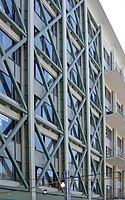
Photo from wikipedia
Abstract Masonry structures strengthened with textile-reinforced concrete (TRC) have been extensively studied, and many results have confirmed the TRC-strengthened effectiveness. The present paper demonstrated the experimental investigation on the compressive… Click to show full abstract
Abstract Masonry structures strengthened with textile-reinforced concrete (TRC) have been extensively studied, and many results have confirmed the TRC-strengthened effectiveness. The present paper demonstrated the experimental investigation on the compressive performance of TRC-confined masonry columns in terms of failure mode, carrying capacity, deformability and energy dissipation. The prediction formulas of the compressive strength and ultimate strain were also proposed based on the test results in this paper and available data in other literature. The results indicated that the brittle failure feature of unconfined masonry columns was relieved after TRC confinement. The specimens confined with the carbon-glass TRC showed a better ductile behavior compared with that of the basalt-glass TRC because a relatively poor ability to disperse cracks was observed for basalt-glass TRC-confined specimens in this test. The carrying capacity, deformability and energy dissipation of the specimens after TRC confinement all gained the different degrees of increase, and the increased effectiveness of the carbon-glass TRC-confined specimens was more prominent compared with that of basalt-glass TRC. The compressive strength of TRC-confined masonry columns can be well predicted by the formula obtained in this paper with a better generality, while the prediction formula of the ultimate strain for TRC-confined masonry columns has a lower accuracy, and needs to be further researched.
Journal Title: Construction and Building Materials
Year Published: 2020
Link to full text (if available)
Share on Social Media: Sign Up to like & get
recommendations!